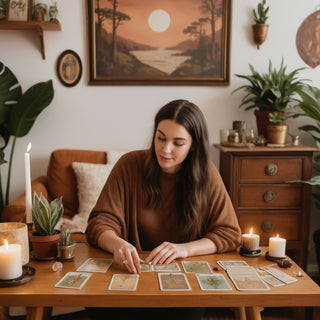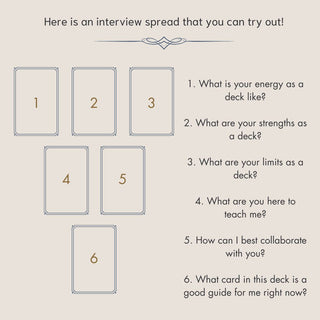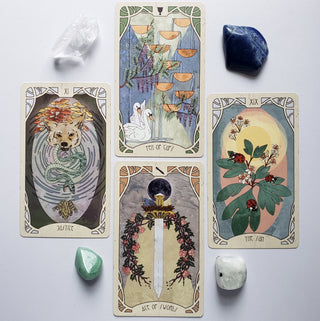
Intro To The Tarot
You’ve got a new tarot deck, and I bet you’re excited to begin reading with it! If you are new to tarot, this pamphlet is designed to help you get started on your journey, with some tips and tricks, a brief history, deck interview spread, and more.
What Is Tarot?
Tarot can be many things, and everyone will have their own idea of what it is and can do. My perception of tarot is that it’s a psychological tool for self-reflection. This can be a spiritual process, a meditative process, a creative process, and more. Ultimately, you are learning to recognize patterns that you might otherwise overlook. Practicing to see and interpret these patterns can provide significant insight, and help us understand ourselves and others on a deeper level.
A Brief History
The earliest tarot-type deck was used in Italy in the 15th century, with 22 illustrated cards (now called the Major Arcana) added as ‘trumps’ over the other four, more traditional playing card suits (now known as the Minor Arcana). During the 18th century, the tarot took on occult associations, adopting the symbolic messages we’re more familiar with today. With the popularity and accessibility of indie publishing, tarot decks now come in all shapes, colors, styles, and themes, so there is something for everyone to enjoy!
Types of Tarot Decks
There are three common types of tarot decks; The Tarot deMarseille, The Thoth Tarot, and The Rider-Waite-Smith (or Smith-Waite, or RWS)Tarot. Each is a little different and offers its own unique style of reading.
How Do You Use Tarot?
There is no right or wrong tarot reading style, but there are some basics that typically everyone will follow when using the cards.
- Clear your mind and create a space conducive to self-reflection. This could mean clearing a physical space to lay your cards down or spending a few minutes meditating.
- Set intentional prompts. What insight do you wish to gain? Think about your questions carefully and write them out, or find a tarot spread that matches the type of information you’re seeking.
- Shuffle the deck. There are many ways to shuffle the cards, some methodical and others more casual. You can use an overhand shuffle, cut the deck, or mix the cards up randomly on a flat surface. Keep your questions at the forefront of your mind while doing so.
- Select your cards. Again, for some this is a very specific, calculated process, and for others more intuitive. You might pick the top or bottom cards after cutting the deck, or fan them out and move your hand over them until you feel drawn to a specific card. Repeat this for each question that you’ve prepared.
- Reveal the cards and interpret their messages. Start by studying the artwork or card face and noting any immediate thoughts or feelings. Then, consult the guidebook that came with the set. Try to apply the messages to your question or situation.
Everyone’s style is different, so find a process that works for you. Try a few different methods out and see which you like best, and then practice until you become more comfortable. Journaling can help tease out the layers of meaning in your reading, and it is a great way to track your growth as a reader. Most importantly, have fun and enjoy the journey of learning to work with your new deck!

Getting To Know Your Deck
It’s important to choose a tarot deck that speaks to you. It’s a myth that you have to be gifted your first tarot deck and that it’s bad luck to purchase your own. Look for styles, themes, and a structure that matches your interests and tarot reading level. Typically, the RWS deck or one following this structure is recommended for beginners.
You can bond with your deck in a few different ways. The first is to pick a card to study each day. Sit with that card and reflect on how it makes you feel, what you notice about the imagery, and what the guidebook tells you about its meaning. Do this each day with a new card until you’ve gone through the entire deck.
Some people will place their tarot decks under their pillow or on a bedside table for a few nights or over a lunar cycle. It’s believed this helps bridge a connection on a subconscious level.
Another way to get familiar with your deck is to do an interview spread. This is a tarot spread with questions designed to illuminate that particular deck’s strengths, weaknesses, and style of reading. I do believe that, because of the range of artwork and types of decks, each can have different ‘personalities’. Some are very gentle, others are much more direct in their messages.
Tips & Advice
Learn at your own pace. Don’t feel rushed to memorize all of the cards quickly. Take your time to immerse yourself in the voice of the deck and the messages each card presents to you.
Use the visual keys in the cards (if you can). Some decks are better for this than others, but you can gain a lot of insight by looking at the artwork. How do the figures look? Are they gesturing? What is the landscape or scenery like? What emotions do the colors bring up for you?
Pay attention to how a card makes you feel/first impressions. You are the conduit for the message of the cards. If you have a particularly strong feeling about an interpretation, go with it, even if it seems counterintuitive to your guidebooks. Remember that tarot is an exercise with your subconscious mind.
Don’t be afraid of those tough, scary, or conflictual cards. Life is full of difficult lessons and events. One way to look at The Tower or The 10 of Swords is to accept the harsh reality they present, but also to find the silver lining underneath. Important growth comes from major change. What new opportunities or perspectives can these cards offer? What can you gain from these experiences?


